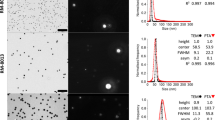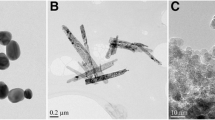Abstract
Accurately estimating the mean size of features within an opaque material using only 2D observations is a common requirement in the materials and medical communities. Attempting to employ numerical methods to obtain an accurate estimate of the full 3D size distribution, which is often important for calculating structure-dependent material properties, is substantially more challenging. This paper circumvents the error propagation issues observed with classical numerical approaches, such as those formulated by Saltikov, Johnson, and Schwartz, through comparison of two calculation methods: (i) the direct simulation of synthetic particles and (ii) inversion of the conventional Saltikov analysis. Each method was used to generate dispersions whose 3D particle diameters followed lognormal distributions of varying shape parameters; the mean and variance were then predicted for 2D cross-sectional measurements. Parameters from both the 2D and 3D distributions were analytically coupled to produce a set of equations for accurately transforming cross-sectional observations into estimates of the full 3D distributions. Accuracy of the 2D-to-3D transformation is, for the first time, characterized as a function of the population size and measurement resolution. Specifically, included figures allow for rapid conversion from 2D to 3D metrics with the corresponding margin of error. The Inverse Saltikov method is shown to provide superior transformation accuracy for the idealized cases of lognormally distributed and randomly dispersed spherical particles when compared to either the Direct Simulation method or classical numerical approaches.









Similar content being viewed by others
Change history
19 August 2021
A Correction to this paper has been published: https://doi.org/10.1007/s11661-021-06406-2
References
J. E. Hillard and R. L. Lawson: Stereology and Stochastic Geometry, 1st edition, Kluwer Academic Publishers, Dordrecht, Netherlands, 2003
M.L. Mendelson: J. Am. Ceram. Soc., 1969,vol. 52, no. 8, pp. 443-446
E.E. Underwood: J. Microsc. 1969 89(2): 161–80
Y. A. Coutinho, S. C. Rooney and E. J. Payton: Metall. Mater. Trans. A, 2017, vol. 48, pp. 2375-2395
A. R. C. Gerlt, L. Semiatin, A. K. Criner and E. J. Payton: J. Am. Ceram. Soc, 2018, vol 102, pp 37-41
P. Louis and A. Gokhale: Metall. Mater. Trans. A, 1995, vol. 26, no. 6, pp. 1449-1456
R. Heilbronner: How to Derive Size Distributions of Particles from Size Distributions of Sectional Areas, Basel University Department of Earth Sciences, Neuchatel, Switzerland, 2002
ASTM E113 -13, Standard Test Methods for Determining Average Grain Size, ASTM International, West Conshohocken, PA, 2013
M. L. Cruz-Orive: J. Microsc. 1976, vol. 107, pp. 235-253
A. R. C. Gerlt, R. S. Picard, A. E. Saurber, A. K. Criner, S. L. Semiatin and E. J. Payton: Metall. Mater. Trans. A, 2018, vol. 49, no. 1, pp. 4424-4428
M. DeGroot and M. Chervish: Probability and Statistics, 4th edition, Pearson Education Inc., Boston, Massachusetts, 2012
S. A. Saltikov: “The determination of the size distribution of particles in an opaque material from a measurement of the size distribution of their section,” in Stereology, 1967, Berlin, Heidelberg, Springer, pp. 163-173
M. Schmidt and H. Lipson: Science 2009, 324(5923): 81-85
C. G. Roberts: “Grain Growth and the Zener Pinning Phenomenon: A Computational and Experimental Investigation,” PhD thesis, Carnegie Mellon University, Pittsburgh, 2007
P. Virtanen and et al: Nature Methods, 2020 vol. 17, pp. 261-272
Author information
Authors and Affiliations
Corresponding author
Additional information
Publisher's Note
Springer Nature remains neutral with regard to jurisdictional claims in published maps and institutional affiliations.
The original online version of this article has been corrected. There were errors in Eq. 26 and Figure 9. In addition, several table and equation citations were corrected in the text.
Manuscript submitted May 4, 2020; accepted October 17, 2020.
Appendix
Appendix
Similar to how mean and standard deviation may be used to characterize a population sample, expectation and variance can be calculated to characterize a continuous function. The equations for doing so are as follows[11]:
Using these two equations as well as Eqs. [8] and [9] above, it is fairly straightforward to calculate \( K_{\ell } \), \( K_{d} \), \( S\left( {\ell /\bar{\ell }} \right) \), and \( S\left( {d /\bar{d}} \right) \) for a single sphere, which is equivalent to a population of spheres where \( \sigma = 0 \).
As can be seen, the calculated values agree almost perfectly with the values seen at σ = 0 in Figures 3(c) through (f).
Rights and permissions
About this article
Cite this article
Gerlt, A.R.C., Criner, A.K., Semiatin, S.L. et al. Non-linear Transfer Functions for Accurately Estimating 3D Particle Size, Distribution, and Expected Error from 2D Cross Sections of a Lognormal Distribution of Spherical Particles. Metall Mater Trans A 52, 228–241 (2021). https://doi.org/10.1007/s11661-020-06072-w
Received:
Accepted:
Published:
Issue Date:
DOI: https://doi.org/10.1007/s11661-020-06072-w




